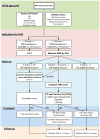Bone disease in HIV infection: a practical review and recommendations for HIV care providers
- PMID: 20839968
- PMCID: PMC3105903
- DOI: 10.1086/656412
Bone disease in HIV infection: a practical review and recommendations for HIV care providers
Abstract
Low bone mineral density (BMD) is prevalent in human immunodeficiency virus (HIV)-infected subjects. Initiation of antiretroviral therapy is associated with a 2%-6% decrease in BMD over the first 2 years, a decrease that is similar in magnitude to that sustained during the first 2 years of menopause. Recent studies have also described increased fracture rates in the HIV-infected population. The causes of low BMD in individuals with HIV infection appear to be multifactorial and likely represent a complex interaction between HIV infection, traditional osteoporosis risk factors, and antiretroviral-related factors. In this review, we make the point that HIV infection should be considered as a risk factor for bone disease. We recommend screening patients with fragility fractures, all HIV-infected post-menopausal women, and all HIV-infected men ⩾50 years of age. We also discuss the importance of considering secondary causes of osteoporosis. Finally, we discuss treatment of the more severe cases of bone disease, while outlining the caveats and gaps in our knowledge.
Conflict of interest statement
All other authors: no conflicts.
Figures
Similar articles
-
Bone health and human immunodeficiency virus infection.Pharmacotherapy. 2013 Jun;33(6):665-82. doi: 10.1002/phar.1257. Epub 2013 Apr 1. Pharmacotherapy. 2013. PMID: 23553497 Review.
-
Bone alterations associated with HIV.Curr HIV/AIDS Rep. 2014 Sep;11(3):233-40. doi: 10.1007/s11904-014-0216-x. Curr HIV/AIDS Rep. 2014. PMID: 25064454
-
Low bone mineral density with tenofovir: does statistically significant mean clinically significant?Clin Infect Dis. 2010 Oct 15;51(8):973-5. doi: 10.1086/656418. Clin Infect Dis. 2010. PMID: 20828303 No abstract available.
-
Bone health in children and adolescents with perinatal HIV infection.J Int AIDS Soc. 2013 Jun 18;16(1):18575. doi: 10.7448/IAS.16.1.18575. J Int AIDS Soc. 2013. PMID: 23782476 Free PMC article. Review.
-
Endocrine complications of human immunodeficiency virus infection: hypogonadism, bone disease and tenofovir-related toxicity.Best Pract Res Clin Endocrinol Metab. 2011 Jun;25(3):501-15. doi: 10.1016/j.beem.2010.11.003. Best Pract Res Clin Endocrinol Metab. 2011. PMID: 21663843 Review.
Cited by
-
Increased fracture risk with HIV infection--a growing concern.Nat Rev Endocrinol. 2013 May;9(5):260-1. doi: 10.1038/nrendo.2013.62. Epub 2013 Mar 26. Nat Rev Endocrinol. 2013. PMID: 23529040 No abstract available.
-
Beyond the Pap Smear: Gender-responsive HIV Care for Women.Yale J Biol Med. 2016 Jun 27;89(2):193-203. eCollection 2016 Jun. Yale J Biol Med. 2016. PMID: 27354845 Free PMC article. Review.
-
Risk of hip fracture associated with hepatitis C virus infection and hepatitis C/human immunodeficiency virus coinfection.Hepatology. 2012 Nov;56(5):1688-98. doi: 10.1002/hep.25866. Epub 2012 Oct 14. Hepatology. 2012. PMID: 22619086 Free PMC article.
-
Risk factors for falls in HIV-infected persons.J Acquir Immune Defic Syndr. 2012 Dec 1;61(4):484-9. doi: 10.1097/QAI.0b013e3182716e38. J Acquir Immune Defic Syndr. 2012. PMID: 23143526 Free PMC article.
-
Clinical experience with intravenous zoledronic acid in the treatment of male osteoporosis: evidence and opinions.Ther Adv Musculoskelet Dis. 2013 Aug;5(4):182-98. doi: 10.1177/1759720X13485829. Ther Adv Musculoskelet Dis. 2013. PMID: 23904863 Free PMC article.
References
-
- Consensus development conference: diagnosis, prophylaxis, and treatment of osteoporosis. Am J Med. 1993;94(6):646–650. - PubMed
-
- Assessment of fracture risk and its application to screening for post-menopausal osteoporosis. Report of a WHO Study Group. World Health Organ Tech Rep Ser. 1994;843:1–129. - PubMed
-
- Foundation NO. Clinician’s guide to prevention and treatment of osteoporosis. Washington, DC: National Osteoporosis Foundation; 2010.
-
- Bruera D, Luna N, David DO, Bergoglio LM, Zamudio J. Decreased bone mineral density in HIV-infected patients is independent of antiretroviral therapy. AIDS. 2003;17(13):1917–1923. - PubMed
Publication types
MeSH terms
Substances
Grants and funding
LinkOut - more resources
Full Text Sources
Other Literature Sources
Medical


